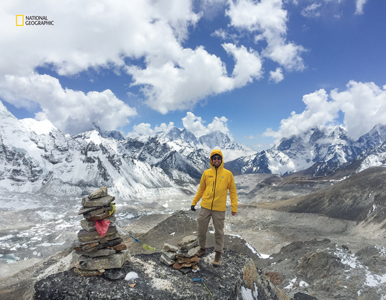
Sam Sheline has gone to great heights for his job.
Last spring, the National Geographic associate producer was part of the 45-person team that scaled Mount Everest to install the world’s highest weather station at 27,650 feet above sea level—just 1,500 feet shy of the summit. The seven-foot-tall, 110-pound structure will help scientists study the subtropical jet stream, a powerful band of winds that are notoriously tricky to track. It will also give researchers a better understanding of the impact of climate change on extreme high-altitude environments, which are “warming significantly faster than global averages,” Sheline says.
The Durham, North Carolina, native spent nearly six weeks at Everest’s base camp shooting video of the 30 geologists, glaciologists, biologists, cartographers, and climate scientists conducting fieldwork. The videos are available in National Geographic Education’s online resource library.
Although Sheline didn’t make it to the “death zone”—the area above 26,247 feet where there’s not enough oxygen for the human body to function, and where most of the more than 200 climbers who’ve died scaling Everest have perished—his stint on Earth’s tallest peak was dangerous, nonetheless. “I had to be evacuated out of base camp by helicopter because of the flu—17,500 feet is not an easy place to get over a fever,” he says of the virus, which ravaged the entire expedition.
As a student in the School of Communication, Sheline worked with the Center for Environmental Filmmaking, researching wildlife filmmaking ethics and planning events. He says the center, which celebrates its 15th anniversary this year, gave him the technical know-how to shoot amid hurricane-force winds and dangerous cold, and helped him hone soft skills like teamwork.
“Nothing can prepare you for seeing an avalanche come a little too close for comfort, but SOC prepared me well for the rest of the job.”